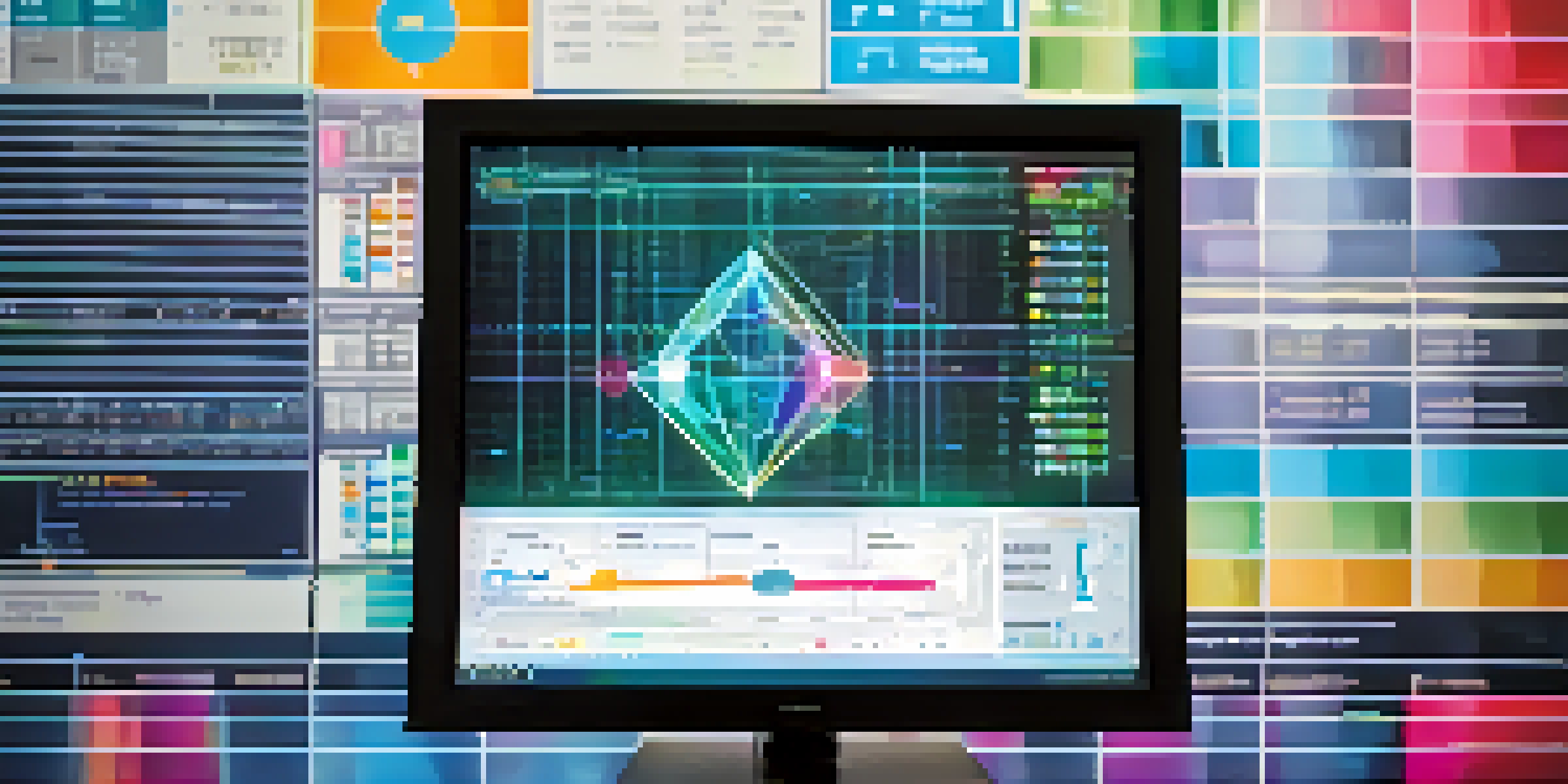AI Algorithms: Improving Early Detection of Diseases

Understanding AI Algorithms in Healthcare
Artificial Intelligence (AI) algorithms are computer programs designed to analyze large datasets and learn patterns. In healthcare, these algorithms can sift through mountains of medical data, identifying trends that might escape the human eye. By utilizing machine learning and deep learning techniques, AI can assist doctors in diagnosing diseases at an earlier stage, potentially leading to better patient outcomes. Think of AI as a super-smart assistant that helps healthcare professionals make informed decisions.
Artificial intelligence is the new electricity.
One of the most exciting aspects of AI in healthcare is its ability to evolve. As these algorithms process more data over time, they improve their accuracy and effectiveness. This is similar to how we learn from our experiences; the more we practice, the better we get. In this way, AI is not just a static tool, but a dynamic solution that adapts to new information and research.
For instance, an AI algorithm trained on thousands of medical images can learn to recognize early signs of diseases like cancer or diabetes. This capability not only speeds up the diagnostic process but also enhances precision, allowing for timely interventions. The integration of AI into healthcare promises a future where diseases can be detected much earlier than ever before.
The Role of Data in Disease Detection
Data is the backbone of any AI algorithm, especially in the field of healthcare. Vast amounts of medical data, including patient records, imaging studies, and genetic information, are essential for training these algorithms. The more quality data we have, the better the AI can learn and identify patterns associated with various diseases. It's akin to feeding a plant with the right nutrients to help it grow strong and healthy.

Moreover, the types of data used can significantly impact the effectiveness of disease detection. For example, integrating diverse data sources—like electronic health records (EHRs), lab results, and even social determinants of health—enables a more comprehensive view of patient health. This holistic approach can uncover hidden risk factors that might contribute to disease, leading to proactive measures rather than reactive ones.
AI Enhances Early Disease Detection
AI algorithms analyze vast medical data to identify disease patterns, enabling earlier diagnoses and improved patient outcomes.
However, it's crucial to ensure that this data is used ethically and securely. Protecting patient privacy while harnessing the power of data is a delicate balance that healthcare providers must navigate. With proper safeguards in place, the potential for AI to revolutionize early disease detection is immense.
Machine Learning Techniques for Early Detection
Machine learning, a subset of AI, plays a pivotal role in early disease detection. It involves training algorithms to recognize patterns in data, which is particularly useful in identifying signs of illness before they manifest physically. For instance, machine learning can analyze patient histories and predict who might develop conditions like heart disease based on seemingly unrelated factors. It's like piecing together a puzzle where each piece contributes to a larger picture of health.
The greatest benefit of artificial intelligence is its ability to enhance human decision-making.
One of the most common techniques used is supervised learning, where algorithms learn from labeled datasets. This means the AI is trained on data that has already been categorized, such as images of healthy versus diseased tissues. As it processes more examples, the algorithm gets better at making predictions, much like a student acing a test after thorough studying.
Unsupervised learning, on the other hand, allows algorithms to find patterns in unlabelled data. This can lead to the discovery of new risk factors or disease markers that weren't previously recognized. By leveraging these machine learning techniques, healthcare providers can enhance their diagnostic capabilities, ultimately improving patient care.
AI in Radiology: Transforming Image Analysis
Radiology is one of the areas where AI has made significant strides in early disease detection. AI algorithms can analyze medical images like X-rays, MRIs, and CT scans with remarkable speed and accuracy. This technology can highlight potential issues that radiologists might overlook, acting as a second pair of eyes. Imagine having a vigilant assistant who never tires, always ready to help catch early signs of disease.
For instance, AI has shown impressive results in detecting lung cancer from chest X-rays. By analyzing thousands of images, these algorithms can learn to identify subtle signs of malignancy that may not be visible to the human eye. This early detection can lead to timely interventions, significantly improving patient survival rates.
Data Quality Drives AI Effectiveness
The success of AI in healthcare relies on diverse and high-quality data, which helps algorithms accurately predict health risks.
Furthermore, the integration of AI into radiology can reduce the workload for healthcare professionals, allowing them to focus on more complex cases. As AI continues to evolve, its role in transforming image analysis will likely expand, bringing us closer to a future where diseases are routinely detected at their earliest stages.
Predictive Analytics: Foreseeing Health Risks
Predictive analytics, powered by AI, is another game changer in early disease detection. By analyzing historical data, these algorithms can identify individuals at high risk for certain diseases before symptoms appear. This proactive approach enables healthcare providers to implement preventive measures tailored to each patient's unique risk profile. It’s like having a crystal ball that offers insights into potential health issues.
For example, predictive models can assess factors such as family history, lifestyle choices, and lab results to forecast the likelihood of developing chronic conditions like diabetes or hypertension. This information empowers patients to make informed decisions about their health, potentially altering the course of their lives.
However, the effectiveness of predictive analytics relies heavily on the quality of the data and the algorithms used. Continuous monitoring and updating of these models are essential to ensure accurate predictions. As technology advances, so will our ability to foresee and mitigate health risks, making early disease detection more effective than ever.
Challenges and Ethical Considerations in AI
While the potential benefits of AI in early disease detection are immense, there are significant challenges and ethical considerations to address. One major concern is the quality and representativeness of the data used to train these algorithms. If the data is biased or incomplete, it can lead to inaccurate predictions, potentially harming patients. Ensuring diversity in datasets is crucial to creating fair and effective AI solutions.
Another important consideration is the transparency of AI algorithms. Many AI models operate as 'black boxes,' meaning their decision-making processes are not easily understood. This lack of transparency raises questions about accountability and trust, especially when it comes to critical health decisions. Patients and healthcare providers alike must feel confident in the technology being used.
Ethics and Transparency are Crucial
Addressing data bias and ensuring transparency in AI algorithms are essential for building trust and accountability in healthcare.
Regulatory frameworks and guidelines are also needed to govern the use of AI in healthcare. Establishing ethical standards will help ensure that AI applications prioritize patient safety and privacy. By addressing these challenges proactively, we can harness the full potential of AI in early disease detection while safeguarding the well-being of patients.
The Future of AI in Early Disease Detection
The future of AI in early disease detection is bright and full of possibilities. As technology continues to evolve, we can expect even more sophisticated algorithms that improve accuracy and efficiency. Innovations in AI, such as natural language processing and advanced imaging techniques, will further enhance our ability to diagnose diseases earlier than ever before. It’s like stepping into a new era of healthcare where technology and human expertise work hand in hand.
Collaboration between AI developers, healthcare professionals, and researchers will be key to unlocking the full potential of these technologies. By working together, we can create robust systems that not only detect diseases but also provide insights for personalized treatment plans. This holistic approach could revolutionize patient care, making it more proactive and tailored to individual needs.

Ultimately, the integration of AI in healthcare has the potential to save lives by catching diseases early and improving treatment outcomes. As we embrace this technology, we move closer to a future where early detection is the norm, not the exception, empowering patients and healthcare providers alike.